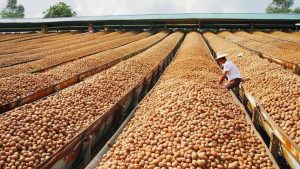You Won’t Believe How Walnut is Produced And What is Made Using Walnut

The Journey of Walnuts: From Orchard to Table
1. Cultivation and Harvesting
Walnuts are primarily grown in orchards, with the United States (especially California) being one of the leading producers. Walnut trees thrive in temperate climates and take several years to mature and start producing nuts.
- Growth: Walnut trees are typically planted in rows with ample space to allow for their expansive canopy. They require well-drained soil and plenty of sunlight.
- Harvesting: Walnuts are harvested in the fall when the outer green husk splits, revealing the hard shell inside. Mechanical shakers are used to shake the trees, causing the walnuts to fall to the ground, where they are collected.
2. Processing and Shelling
Once harvested, walnuts undergo several steps to prepare them for consumption:
- Cleaning: The nuts are cleaned to remove dirt and debris.
- Drying: They are then dried to reduce moisture content, which helps preserve them and prevent mold.
- Shelling: After drying, the walnuts are cracked open using specialized machinery to separate the kernels from the shells.
- Sorting: The kernels are sorted by size and quality, with the best ones being selected for packaging and sale.
What is Made Using Walnuts?
Walnuts are incredibly versatile and can be used to create a variety of products, both culinary and non-culinary.
1. Culinary Uses
- Nut Butter: Walnut butter is a delicious and nutritious spread, perfect for toast, smoothies, or as a dip.
- Baking: Walnuts are a popular ingredient in baked goods like cookies, brownies, and breads, adding a delightful crunch and flavor.
- Cooking: Chopped walnuts can be added to salads, pastas, and grain dishes for added texture and nutritional value.
- Oils: Walnut oil, extracted from the nuts, is used in dressings, marinades, and as a finishing oil due to its rich, nutty flavor.
2. Non-Culinary Uses
- Cosmetics: Walnut oil is often used in skincare products for its moisturizing and anti-aging properties. It can be found in creams, lotions, and hair care products.
- Woodworking: Walnut wood is highly prized for its durability and beautiful grain, making it a popular choice for furniture, flooring, and decorative items.
- Dye: The husks of walnuts can be used to create natural dyes for fabrics and crafts.
Health Benefits of Walnuts
Walnuts are not only delicious but also packed with nutrients:
- Rich in Omega-3 Fatty Acids: These healthy fats support heart health and brain function.
- High in Antioxidants: Walnuts contain powerful antioxidants that help fight inflammation and oxidative stress.
- Good Source of Vitamins and Minerals: They provide essential nutrients like vitamin E, magnesium, and potassium.
